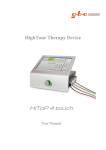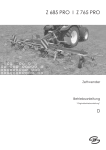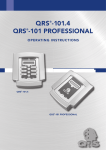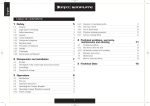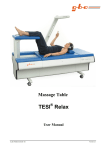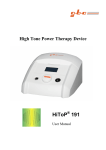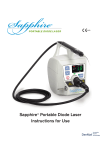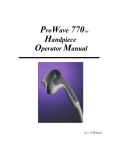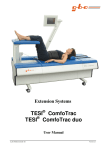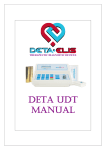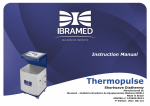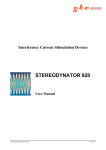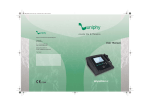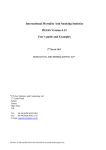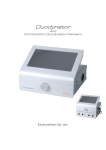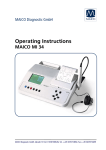Download RADIOTHERM 1006 - gbo Medizintechnik
Transcript
Microwave Therapy Unit RADIOTHERM 1006 User Manual gbo Medizintechnik AG 2006 Version 1.5 2 RADIOTHERM 1006 The gbo Medizintechnik AG has taken care in preparation of this manual, but makes no expressed or implied warranty of any kind and assume no responsibility for errors or omissions. All rights reserved. No part of this manual may be reproduced, in any form or by any means (electronic, mechanical, or otherwise) without the prior written permission of the gbo Medizintechnik AG. © gbo Medizintechnik AG 2006 gbo Medizintechnik AG Kleiststrasse 6 D-64668 Rimbach Telefon: Telefax: E-Mail: Internet: Version Date of issue +49 6 25 3/808-0 +49 6 25 3/808-245 [email protected] http://www.gbo-med.de 1.5 February 17th, 2010 gbo Medizintechnik AG 2006 Version 1.5 RADIOTHERM 1006 3 Warnings and safety precautions Warning! Warnings which have to be observed by all means! Caution! Observe the instructions for use! !! Note! Information that will facilitate your work. gbo Medizintechnik AG 2006 Version 1.5 4 RADIOTHERM 1006 Contents 1 PURPOSE 5 1.1 Intended Use 5 1.2 The Microwave Therapy Unit RADIOTHERM 1006 5 2 START OF OPERATION 6 2.1 Transport and Assembly 6 2.2 Connecting the radiator cable 6 2.3 Installing the radiator 7 2.4 Power connection 7 3 FUNCTIONAL DESCRIPTION 8 3.1 Control Panel 3.1.1 Power switch 3.1.2 Modes of operation 3.1.3 Treatment time 3.1.4 STOP 3.1.5 Dosage knob 3.1.6 Unit malfunctions 8 9 9 9 9 9 10 3.2 Radiators 3.2.1 Circular field radiator 3.2.2 Focus radiator 3.2.3 Cradle radiator 3.2.4 Long field radiator 10 10 10 10 11 4 THERAPY 12 4.1 Important radiation application instructions 12 4.2 Contraindications 14 5 BEHAVIOR IN CASE OF TROUBLES 14 6 MAINTENANCE 15 6.1 Safety controls 15 6.2 Cleaning, disinfection and care 15 7 WARNINGS AND SAFETY PRECAUTIONS 16 8 EXPLANATION OF THE SIGNS USED 17 9 TECHNICAL DATA 18 10 ACCESSORIES 19 APPENDIX A: INDICATION LIST gbo Medizintechnik AG 2006 20 Version 1.5 RADIOTHERM 1006 5 1 Purpose 1.1 Intended Use The RADIOTHERM 1006 is a microwave diathermy unit with a wide range of application. The RADIOTHERM 1006 generates constant and pulsating microwave energy for thermic and non-thermic use. While subcutaneous fatty tissue is not affected, muscles, ligaments, tendons and joints are favorably affected by microwave radiation: improved blood circulation, increased cell metabolism, spasmolysis and pain relief are considered to be among the most important effects which can be achieved after a relatively short course of treatment. The field of application is extended by the pulsed operation. Even acute inflammatory processes can be treated. 1.2 The Microwave Therapy Unit RADIOTHERM 1006 This high-power unit for microwave thermotherapy is working at a wave length of 12.2 cm in air. Its special features are: • Selection between continuos and pulse mode. • Reliable relation between optimal dosage in the depth of the body and subjective heat sensitivity on the skin. Warming up the superficially well conducting tissue areas, such as: joints, tendons, muscles and ligaments. Low stress on the subcutaneous fatty tissue. • High depth effect by means of pulse operation. • Simple handling of the unit and the accessories. • Wide range of applications due to different radiators, such as: cradle type, circular field, focus and long field radiator. • To supply a constant dose, it is only necessary to select therapy time and output. The therapy timer automatically switches off the generator at the end of the treatment time. • Universal holding bracket facilitates application; it can be easily adjusted to any required position. The RADIOTHERM 1006 essentially consists of 6 assemblies. • • • • • • Anode and control transformer, mounted on the bottom of the housing. Control electronics mounted on the anode transformer. Magnetron with filter and fan. High-voltage board mounted on the side panel. Operation panel mounted on the top plate. High-frequency-output cable with radiator. This design allows a very easy service. gbo Medizintechnik AG 2006 Version 1.5 6 RADIOTHERM 1006 2 Start of Operation Before starting up the unit and prior to every therapy session, ensure that no patients who are fitted with electronic implants (e.g. cardiac pacemaker) or implanted electrodes enter rooms where microwaves are to be used. There must be no metallic parts at the body of the patient (watches, jewel, money or similar). As well as other metallic or metalliferous parts (couch, chairs, cupboards) should not be in the direct field of the radiator (Absorption and reflection of the radiation). Particular care must be exercised when handling radiators as rough treatment could change the radiator radiation characteristics. Persons not being treated should remain at a distance of not less than 1.5 m from a radiator while it is being used for therapy. Staff operating the unit should not remain in the high frequency field any longer than absolutely necessary for specific treatment purposes. The unit must be operated only by persons who by reason of their knowledge and practical experience will ensure proper use of the unit. 2.1 Transport and Assembly The RADIOTHERM 1006 is provided with four casters. Two of them can be locked to prevent accidental movement of the unit. A wall distance of at least 20 cm has to be provided. The device should not be placed in front of radiators. The RADIOTHERM 1006 is in accordance with the EC directive for medical devices (93/42/EWG) and corresponds to the DIN EN 60601. and is a unit of Protection Class I. The unit is assigned to class IIa of the MDD. Warning! 2.2 Connecting the radiator cable Attach the radiator cable to the device by securing the cable to the unit with the screw connection for the radiator cable (tighten firmly!). Ensure that the free end of the cable engages in the end of the holding bracket receptacle. gbo Medizintechnik AG 2006 Version 1.5 RADIOTHERM 1006 7 2.3 Installing the radiator Connect the radiator directly to the coupler in the end of the holding bracket by pulling back the locking ring of the coupler towards the holding bracket. Insert the radiator connector fully into the coupler and release the locking ring which must spring back into its original position. Push and pull the radiator in the axial direction of the coupler to ensure that the locking ring has also properly engaged. The radiator is now firmly connected. To detach the radiator, pull back the locking ring again. 2.4 Power connection The RADIOTHERM 1006 is designed for connection to a power line of 230 V respectively 115 V. The voltage is stated on the nameplate. The unit will operate in the power line frequency range from 48 Hz to 62 Hz. Connect the unit with the power cord to a grounded power outlet. The protection of the mains has to be of type slow blow fuse 16 A – 230 V respectively 20 A - 115 V. gbo Medizintechnik AG 2006 Version 1.5 8 RADIOTHERM 1006 3 Functional description 3.1 Control Panel 7 min 5, 6 9 Watt 1 3 2 10 STOP 4 Int 8 Figure 1: Control Panel 1 continuous operation 6 treatment time 2 pulse operation (high output) 7 control display (treatment time) 3 pulse operation (low output) 8 dosage knob 4 STOP- button 9 control display (dosage) 5 treatment time 10 error light (LED) gbo Medizintechnik AG 2006 Version 1.5 RADIOTHERM 1006 9 3.1.1 Power switch By pushing the green power switch ( 1 ) the RADIOTHERM 1006 will be switched on. The green indicator lamp lights up and in each of the displays appears a “0”. 3.1.2 Modes of operation By activating the buttons (1, 2 or 3) the individual operation mode can be selected. The corresponding LED, which is integrated in each mode of operation button, lights up. Following operation modes can be selected: • continuous operation, rated power 200 W (1) • pulse operation (high output), rated power 200 W (2) • pulse operation (low output), rated power 25 W (3) Application with the focus radiator is only possible in the operation mode pulse (low output 25 W). A brief description of the different radiators as well as their purpose in given in chapter 3.2 and appendix A. If no mode of operation is selected (the LED (10) blinks), or no treatment time is set up, the power output cannot be activated. If a false mode of operation is selected, or a wrong (or no) radiator is connected, there appears a “E2” in the display which is addional indicated acoustically, when you try to adjust the output power. Possible causes for a wrong operation or a malfunction are given in chapter 3.1.6. 3.1.3 Treatment time The treatment time can be preselected from 1 to 20 minutes using the adjustment switches (5 or 6). The timer only starts if the dosage knob (8) is turned out of its zero position. The remaining treatment time is indicated in the corresponding display (7). After the preselected time has expired, the set power is automatically switched off. 3.1.4 STOP By pushing the STOP button (4) the RADIOTHERM 1006 will be automatically turned into the start up. The error LED (10) lights up. You have to reselect the mode of operation and the treatment time. Please ensure that the dosage knob is turned into its zero position. 3.1.5 Dosage knob By turning the dosage knob (8) out of the zero position, the selected mode of operation lights up for the according power range. The output power can be continuously adjusted. Turn to right increates the power, turn to left reduces the power. After the treatment time has expired, you will hear a signal. Additional the according STOP signal (LED) (10) lights up . Before a new start you have to return the dosage knob (8) to left. The STOP signal (10) will turn off. gbo Medizintechnik AG 2006 Version 1.5 10 RADIOTHERM 1006 3.1.6 Unit malfunctions The following list shows some reactions of the unit and the possible corresponding problems: Attention! With the software versions 1.0 and 1.1, there is no error message “E3”. In these versions, “E3” and “E1” are combined in “E1”. • The LED (10) blinks + power output cannot be activated (8) => No mode of operation is selected • The LED (10) is on but power output cannot be activated (8) => No treatment time is set up • LED (10) blinks and when the dosage knob (8) is turned on, you can hear a signal and the display shows “E2” => a) No or a wrong radiator is connected b) There is short-circuit or an interruption in the output circuit c) The magnetron is overheated • About 4 seconds after adjusting the power, or during the treatment, the display shows “E3” with an additional acoustic signal and the output power is shut down => The output power was 21%-50% higher as the adjusted power. We allow up to 20%. • Immediately after adjusting the power, or during the treatment, the display shows “E1” with an additional acoustic signal and the output power is shut down => The output power was more than 50% higher as the adjusted power. • Any of the described reactions => a) Impermissible external disturbance (HF-radiator or similar) b) Internal malfunction of the unit You can turn off the malfunction signals by turning the dosage knob (8) counterclockwise or by pressing the stop-button (4). If a malfunction cannot be traced back to a maloperation, a technical service has to be commissioned or the unit should be sent to us. 3.2 Radiators For an optimum use of the microwave therapy unit RADIOTHERM 1006 the suitable radiator applied is of vital importance. The appendix A shows some further recommendations for typical applications. 3.2.1 Circular field radiator The circular field radiator, the so called distance radiator, is used for irradiation of body parts with locally defined disease processes (shoulder or knee-joint, jaw joint, lower arm carpal region, tendo vaginitis, etc.). The proper treatment distance between radiator and body part should be about 10 cm. If the distance is increased the set power output is distributed upon a larger area and thus upon a larger body volume. This means that the power output meeting the affected body per surface unit is decreased. By that also the yielded warmth is reduced. 3.2.2 Focus radiator This contact radiator is determined for treating very tightly limited body parts. This kind of radiator is preferably used for the head area (ENT etc.). During the treatment the radiator is to lay upon the skin. The focus radiator can only be used in the pulsed mode (low output) (3), i.e. that the max. output power is limited to 25 watts. This is granted by a radiator identification. 3.2.3 Cradle radiator This radiator has to be put generally direct on the application area. A sufficient distance between radiator and the patient's body is already provided by its design. The trough type radiator enables a comprehensive exposure to radiation of body parts of medium and large diameter. gbo Medizintechnik AG 2006 Version 1.5 RADIOTHERM 1006 11 By concentric penetration of the energy a higher depth effect can be reached imposing the same strain to the skin. 3.2.4 Long field radiator This radiator is used for irradiation of elongated parts of the body. The proper treatment distance between radiator and body part should be about 5 cm. gbo Medizintechnik AG 2006 Version 1.5 12 RADIOTHERM 1006 4 Therapy 4.1 Important radiation application instructions If appropriately performed the therapeutical application of the microwave radiation is as successful as dangerless. Basically, however, for each radiation a strictest medical indication is required. Warning! Furthermore the following safety regulations are to be adhered to at any rate: • Only original accessories may be used. Damaged accessories must not be used. • As a precaution, persons remaining in the treatment room should remove metal objects (e.g. watches, jewellery, coins, check cards) and electronic instruments (e.g. hearing aids, pagers). • For optimum therapeutic benefit, the patient or the body area to be treated should be completely relaxed. Comfortable seating and lying are the most conductive conditions. • During therapy, a high frequency field is present at a distance of about 1.5 m around the radiator and its cables. Persons within this range should not therefore touch metal objects. Metal objects, for example watches, items of jewelry, keys, purses, knives, metal-framed spectacles, except protective goggles, must be removed as they warm up faster and more intensively in the area of microwaves than the body tissue. • Electronic instruments such as hearing aids, pocket calculators and watches can be affected or damaged and should therefore be placed outside the high frequency field. This also applies, for example, to textiles or toupees containing metal threads and metal zips. • During therapy, persons within the 1.5 m range must also not be touched. • Patients must not be treated on metal chairs, metal couches or mattresses having metal parts integrated or being covered with semiconducting material. • The parts of the body to be treated should if possible be irradiated in the unclothed state. This will reveal whether special protective measures are necessary, for example because of implants. In particular, items of underwear made from man-made fibers must be removed because of their lack of absorption, since accumulations of moisture on the skin (skin folds) may cause localized excessive heating at these places. Damp items of clothing should not be worn. Dry linen (bandages) can be irradiated. • For irradiation in the head and neck region, the patient must wear protective goggles as a precautionary measure to protect the eyes. Application is only allowed in impulse mode (low output 25 W) (3). Especially careful dosage and constant observation is necessary as the eyes themselves do not have heat perception and irreversible damage may be caused very easily. • Implants High frequency thermotherapy is contraindicated for patients with cardiac pacemakers. Body parts with metal inclusions such as endoprotheses, shrapnel, medullary pins, dental fillings, intrauterine pessaries etc., may be treated with only very low doses. • Pregnant women Irradiation of pregnant women in the abdominal region is contraindicated. gbo Medizintechnik AG 2006 Version 1.5 RADIOTHERM 1006 13 • Organs at risk Be careful when dosing organs of low vascularization and blood circulation, e.g. eyes, testes etc. • Small children When exposing small children to radiation due to the body volume a very carefully dosing and constant observation (checking of the skin temperature by laying on the hand and having the unit switched off) is required. It is very useful, therefore, to totally undress small children for the treatment. Warning! • Only select the output when the radiator is applied to the patient. Never operate the unit without a patient ! • The radiators must be positioned so that adjacent parts of the body are irradiated as little as possible. • When treating slender parts of the body, e.g. a wrist, ensure that the radiator is aligned so that sensitive parts of the body (e.g. eyes, testes) are outside the irradiated area, and not inadvertently covered by the part of the body being irradiated (wrist). • Successful treatment requires dosage and treatment times specifically suited to each particular case. The patient's sensitivity to heat is the deciding factor for dosage. • Dose individually and never undifferentiated. Each patient has a different feeling of warmth. • The dose should never be more than tolerable. Heat discomfort or a burning pain during treatment indicate an overdose. Remember that the patient's sensitivity to heat may be disturbed! Parts of the body with local anaesthesia should not or only carefully be irradiated! • The feeling of warmth of the patient is subject to heavy variations during the course of a treatment (adaption). A diminished feeling of warmth during treatment is by no means to induce the doctor in attendance to select a higher dosage than the initial one. Provisions should be made to control the subjective feeling of the patient and the objective skin reaction. • For acute illnesses, it is advisable to start with low intensity and a short treatment time, and then to increase these according to tolerance. • For chronic diseases, however, high intensity and a long treatment time are recommended. • In cases of discomfort, first use the pulsed mode then continue treatment at a lower intensity. Chronic processes on the skeletal system require more intensive heating. In general the patient's subjective sensitivity to heat can be divided into four stages: Dose I: Heat not perceptible. First set dose so that there is a slight sensation of heat, and then control back slightly. Dose II: Heat just perceptible. gbo Medizintechnik AG 2006 turn Version 1.5 14 RADIOTHERM 1006 Dose III: Heat noticeable, pleasant. Dose IV: Heat still tolerable. 4.2 Contraindications • Patients with electronic implants (e.g. cardiac pacemakers, hearing aids) • Patients with metallic implants (e.g. endoprotheses) • Parts of the body with metal inclusions (e.g. medullary pins, shrapnel) • Irradiation of pregnant women in the abdominal region • Tuberculosis • Malignant tumours • Epiphyseal cartilages in children until completion of growth !! Note! This list makes no claims to completeness. The physician must decide in each individual case on suitability and treatment criteria. 5 Behavior in case of troubles Experience has shown that most apparent faults are merely the result of accidental handling errors. Therefore, before assuming that the unit is faulty, check that the operating instructions have been correctly followed. If adjacent electronic equipment (e.g. photometers, telephone systems, computers) suffers from interference from microwave radiation, it must be screened. A change in the radiation beam direction may possibly be a remedy. If interference nevertheless persists, please notify the after-sales service of your dealer. Under no circumstances should you yourself or unskilled persons acting on your behalf attempt to remedy the fault; the interior of the unit contains high voltages which represent a danger to life. gbo Medizintechnik AG 2006 Version 1.5 RADIOTHERM 1006 15 6 Maintenance Functionality, reliability and safety characteristics of HighTone Therapy devices are only guaranteed if properly used in accordance with the operating instructions. Safety control, maintenance, repair and modifications shall be carried out by the manufacturer or the service agents authorized by him. In case of a failure, parts which influence the safety of the device shall be replaced only by original spare parts of the manufacturer. The electric installation shall be carried out in accordance with the requirements of VDE/IEC. The device does not contain any parts which need maintenance work done by the user. 6.1 Safety controls The device is subject to the provisions of the MDD. The safety controls have to be carried out on the basis of this law. Thereby, the operator regulation has to be especially observed. Irrespective of the legal rules or beyond the scope of the MDD, it is recommended to have the device checked by the manufacturer or by a service agency authorized by him at 12-months intervals. The check shall consist of at least the following: • Electrical safety check in accordance with the check plan of the manufacturer, • Check of the device in respect of external integrity, • Check of all display and operating elements in respect of damage, • Check of all inscriptions in respect of legibility. 6.2 Cleaning, disinfection and care • Switch off the unit. • Before any cleaning or disinfection, remove the power plug from the power outlet. • The unit and its accessories may only be wiped with agents which do not contain any phenol derivatives, alcohol, chlorine compounds or peracetic acid. • We recommend wiping parts with a cotton wad or cloth moistened with a disinfectant on an aldehyde base. Do not immerse parts in disinfectant solution. • Ensure that the electrical contacts of plugs and sockets do not get wet and that liquid does not enter the unit. • The unit, radiators and cables must not be sterilized in hot steam or gas. gbo Medizintechnik AG 2006 Version 1.5 16 RADIOTHERM 1006 7 Warnings and safety precautions Warning! • In case of patients with implanted electronic device please carry out Therapy only after having checked whether there is any risk. • Pieces of jewellery and glasses have to be taken off during the treatment. • Turn off cellular phones and radiophones or place them in a distance of 3 m from the device. • Cardiac pacemakers can extremely be disturbed. In these cases the therapy should be carried out only under continuous pulse and ECG control. • If the patient and/or the patient cable is in direct range of another high frequency, shortwave or microwave therapeutic device, a damage to the device or an injury to the patient cannot be excluded. Please keep a distance of at least 3 m. • The device is not designed for use in non-explosion-proof areas. If it is used in dangerous anesthesia areas, an explosion cannot be excluded. • Contraindications (see also chapter 4.2): - Patients with electronic implants (e.g. cardiac pacemakers, hearing aids) - Patients with metallic implants (e.g. endoprotheses) - Parts of the body with metal inclusions (e.g. medullary pins, shrapnel) - Irradiation of pregnant women in the abdominal region - Tuberculosis - Malignant tumours - Epiphyseal cartilages in children until completion of growth !! Note! This list makes no claims to completeness. The physician must decide in each individual case on suitability and treatment criteria. • In case of any visible failures please contact immediately gbo Medizintechnik AG or one of the service agencies authorized by gbo Medizintechnik AG. gbo Medizintechnik AG 2006 Version 1.5 RADIOTHERM 1006 17 8 Explanation of the signs used 0123 CE-mark Caution! Pay careful attention to the operating instructions! Connector for patient cable; Type B, unit suitable for external and internal application to the patient, except to the heart. Non ionizing radiation This product complies with WEEE Directive 2002/96/EG (waste electrical and electronic equipment). Separate collection for electrical and electronic equipment. gbo Medizintechnik AG 2006 Version 1.5 18 RADIOTHERM 1006 9 Technical data The RADIOTHERM 1006 is a microwave unit for thermotherapy in hospitals and private practices. • Rated HF output 600 W / Pulse operation, peak 200 W / Continuous operation 25 W / Pulse operation (low output) • Operating frequency 2.450 MHz +/- 50 MHz • Output setting continuos • Power connection 230 V, 48 - 62 Hz (other voltages on request) • Power fuse 16 A slow-blow • Power consumption 690 VA • Tube Magnetron • Dimensions 420 x 970 x 410 mm³ (W x H x D) • Weight 43 kg • Regulations Medical-Device-Directive (EEC) • Protection class I • Protection degree B, according to DIN EN 60601 • Protection against ingress of liquids IP X1 • Equipment class IIa • Power supply fuse T 3.15 A (230 V), T 6.3 A (115 V) • Therapy time max. 20 minutes • Environmental conditions: Operation of the device: Transport and storage : Temperature range +10 °C ... +40 °C Relative humidity 30 ... 75 % Temperature range +5 °C ... +50 °C Relative humidity < 90 %, none condensing gbo Medizintechnik AG reserves the right to modify the design and spezification without prior notice. gbo Medizintechnik AG 2006 Version 1.5 RADIOTHERM 1006 19 10 Accessories Microwave-therapy-unit/accessories: article number: • RADIOTHERM 1006 incl. • 020-0-1006-115 (115 V Version) • 020-0-1006-230 (230 V Version) coax cable, anti-ray-goggle, indicator lamp user manual • Holding bracket • 020-453454 • Coax-cable • 45 93 342 EH 729 • Anti-ray-goggle • 45 39 383 EH 729 • Indicator lamp • 45 39 391 EH 729 • Circular radiator, 160 mm ∅ • 011-0-0012 • Cradle radiator • 011-0-0011 • Focus radiator • 011-0-0008 • Long field radiator, • 011-0-0009 • User manual RADIOTHERM 1006, English • 020-7-0006 gbo Medizintechnik AG 2006 Version 1.5 20 RADIOTHERM 1006 Appendix A: Indication list Note: This list makes no claims of completeness. The doctor has to decide in each individual case on suitability and treatment criteria. Disease Typ of radiator*) Intensity [W] Time [min] Number of sessions Frequency of sessions R+C R+C R+C R R+C L+C L+C R+L+C R+C R R+C C R+L 20-50 25-50 30-70 40-90 30-80 50-100 60-100 40-100 80-140 25-50 40-120 50-130 30-80 10-15 20 15 10-15 15 15 15-20 10-20 15-20 5-10 15 15 15 5-10 12 5-10 5-10 5-10 1-5 months 1-10 10-15 10 12 12 10 every other day every other day daily daily daily daily 1 x weekly daily every other day daily 2 x weekly 2 x weekly daily R+C R+C R+C 40-100 40-100 40-100 15 15 15 15 15 10 2 x weekly every other day 2 x weekly Bones, Joints, Muscles: Arthritis, subacute Bursitis Sprains Epicondylitis Contusions Lumbago, acute Bechterew' disease Myalgia Periarthritis Periostitis Polyarthritis Spondylosis Tendovaginitis Respiratory Organs: Bronchiectasia Bronchitis Pleuritis gbo Medizintechnik AG 2006 Version 1.5 21 RADIOTHERM 1006 Disease Typ of radiator*) Intensity [W] Time [min] Number of sessions Frequency of sessions R R R R 20-50 40-80 30-60 20-40 5-10 10 10 5-10 5 5 5 10 L+C L+C L L 40-80 70-130 40-100 30-70 15 15 10 10 12 12 5-10 10 R+L 40-100 10-15 12 R R 30-60 30-60 5-10 10 5-10 5-10 every other day every other day 2-5 2-7 2-9 3-9 5-7 2-5 3-6 5 5-10 5 3-5 3-5 3-5 3-8 5-10 6-10 5 5 daily every other day every other day every other day 2 x weekly daily Skin and its Appendages: Frostbite, localized, fresh Frostbite, localized, old Furuncel, carbuncel Hiradenitis daily 2 x weekly daily daily Peripheral Nerves: Sciatica, acute Sciatica, chronic Neuralgia Neuritis 2 x weekly 2 x weekly daily every other day Circulatory Organs: Peripheral circulatory disturbances 2 x weekly Gynecological Diseases: Mammary abscess Mastitis Ear, Nose, Throat: ATTENTION: use goggles ! facial foruncel Inflammation of temporomandibular Sinustius Laryngitis, non-spec. Othematoma Otitis media gbo Medizintechnik AG 2006 R+F R+F R+F R+F R+F R+F Version 1.5 22 RADIOTHERM 1006 Disease Ear, Nose, Throat: Typ of radiator*) Time [min] Number of sessions Frequency of sessions 3-6 5-7 5-7 5 5-8 3-5 3-5 5 5 every other day daily every other day 7-10 3-10 3-6 3-10 3-10 3-6 5-10 10 5-10 5-10 10 10 3-10 3-10 3-10 3-10 3-10 3-10 daily daily daily daily daily daily ATTENTION: use goggles ! Tympanic cavity discharges Peritonsillar abscess Sialitis Teeth, Oral Cavity: Intensity [W] R+F R+F R+F ATTENTION: use goggles ! Dental abscesses Synovial temporomandibular diseases Gingivitis Parulis Status post extractionem Stomatitis R+F R+F R+F R+F R+F R+F *) Type of Radiator: • • • • R = Circular Radiator, 160 mm ∅ C = Cradle Radiator F = Focus Radiator L = Long Field Radiator gbo Medizintechnik AG 2006 Version 1.5 23 RADIOTHERM 1006 Notes in accordance with EC directive and Medical Devices Directive (MDD) The RADIOTHERM 1006 is a line-powered device for Microwave Therapy of protection class I. The device is in accordance with the EC directive for medical devices (93/42/EWG) and therefore carries the CE sign with the registration number of the notified body for medical devices. The according graphical symbol is placed on the type plate. According to the MDD, RADIOTHERM 1006 is a class IIa device. The manufacturer is only responsible for the safety, operational reliability and functionality of the device if: • the device is used in accordance with the instructions for use; • the electrical installation of the location where the device will be used meets the respective current requirements of electrical safety; • the device is not used in hazardous environments and humid locations; • mountings, amplifications, re-adjustments, modifications or repair works are carried out only by personnel authorized by the manufacturer; • the operator regulation of this EC directive is observed within the scope of MDD. Technical support may be obtained by the manufacturer, dealers or service authorized by the manufacturer. The product’s duration of life as scheduled by the manufacturer is 10 years. RADIOTHERM 1006 is an electronic device. For its disposal the according regulations for electronic devices have to be observed. On request, the manufacturer will provide you with further technical descriptions for all repairable parts of the device, such as circuit diagrams, spare parts lists, and adjustment instructions as far as these are necessary for the qualified technical staff of the operator. Comments on electromagnetic compatibility (EMC) Medical, electrical devices are subject to special precautions concerning the EMC. They must be installed and operated according to the EMC-advice given in the accompanying documents. In particular medical, electrical devices may be influenced by portable and mobile RF-communication devices. The manufacturer guarantees the conformity of the unit with the EMC-requirements only when using accessories which are listed in the EC declaration of conformity. The usage of other accessories my cause an increased emission of electromagnetic disturbances or may lead to a reduced electromagnetic immunity. The unit must not be arranged physically close to other devices or stacked with them. If such an order is necessary nevertheless, the unit must be observed in order to check it for the intentional operation. You find more EMC-comments in the chapter “Warnings and Safety Precautions” of this manual as well as in the Technical Information on the next two pages. gbo Medizintechnik AG 2006 Version 1.5 24 RADIOTHERM 1006 In accordance with the EMC-regulations for medical products we are obliged by law to provide the following information. Guidance and manufacturer’s declaration — electromagnetic emissions The equipment is intended for use in the electromagnetic environment specified below. The customer or the user of the equipment should assure that it is used in such an environment. Emissions test Compliance Electromagnetic environment – guidance RF emissions, Group 2 The equipment must emit electromagnetic energy in order to perform CISPR 11 its intended function. Nearby electronic equipment may be affected. RF emissions, Class B The equipment is suitable for use in all establishments, including CISPR 11 domestic establishments and those directly connected to the public low-voltage power supply network that supplies buildings used for Harmonic emissions, Class A domestic purposes. IEC 61000-3-2 (*) Voltage fluctuation/flicker Complies emissions, IEC 61000-3-3 (*) (*) Note: For devices with a power consumption between 75 W and 1000 W only. Guidance and manufacturer’s declaration — electromagnetic immunity The equipment is intended for use in the electromagnetic environment specified below. The customer or the user of the equipment should assure that it is used in such an environment. Immunity test IEC 60601- test level Compliance level Electromagnetic environment – guidance Electrostatic discharge (ESD), IEC61000-4-2 Electrical fast transient/burst, IEC 61000-4-4 Surge, IEC 61000-4-5 Voltage dips, short interruptions and voltage variations on power supply input lines, IEC 61000-4-11 Power frequency (50/60 Hz) magnetic field, IEC 61000-4-8 ±6 kV contact ±6 kV contact ±8 kV air ±8 kV air ±2 kV for power supply lines ±2 kV for power supply lines ±1 kV for input/output lines ±1 kV differential mode ±1 kV for input/output lines ±1 kV differential mode ±2 kV common mode <5% Uτ for ½ cycle (>95% dip) ±2 kV common mode <5% Uτ for ½ cycle (>95% dip) 40% Uτ for 5 cycles 60% dip) 40% Uτ for 5 cycles 60% dip) 70% Uτ for 25 cycles 30% dip) 70% Uτ for 25 cycles 30% dip) <95% Uτ for 5 s (>5% dip) <95% Uτ for 5 s (>5% dip) 3 A/m 3 A/m Floors should be wood, concrete or ceramic tile. If floors are covered with synthetic material, the relative humidity should be at least 30 %. Mains power quality should be that of a typical commercial or hospital environment. Mains power quality should be that of a typical commercial or hospital environment. Mains power quality should be that of a typical commercial or hospital environment. If the user of the equipment requires continued operation during power mains interruptions, it is recommended that the equipment be powered from an uninterruptible power supply or a battery. Power frequency magnetic fields should be at levels characteristic of a typical location in a typical commercial or hospital environment. Note: Uτ is the a.c. mains voltage prior to application of the test level. gbo Medizintechnik AG 2004 Version 1.5 25 RADIOTHERM 1006 Guidance and manufacturer’s declaration — electromagnetic immunity The equipment is intended for use in the electromagnetic environment specified below. The customer or the user of the equipment should assure that it is used in such an environment. Immunity test IEC 60601- test level Compliance level Electromagnetic environment – guidance Portable and mobile RF communications equipment should be used no closer to any part of the equipment, including cables, than the recommended separation distance calculated from the equation applicable to the frequency of the transmitter. Conducted RF, IEC 61000-4-6 Radiated RF, IEC 61000-4-3 3 Vrms 150 kHz to 80 MHz 3 V/m 80 MHz to 2,5 GHz Recommended separation distance: d=1,2√P 3 Veff 3V/m d=1,2√P for 80 MHz to 800 MHz d=2,3√P for 800 MHz to 2,5 GHz Where P is the maximum output power rating of the transmitter in watts according to the transmitter manufacturer and d is the recommended separation distance in meters (m). Interference may occur in the vicinity of equipment marked with the following symbol: Recommended separation distances to portable and mobile RF communication equipment The equipment is intended to be operated in an electromagnetic environment, where radiated RF interference is controlled. The user can help in avoiding interferences by means of meeting minimum separation distances between portable and mobile RF communication equipment (transmitters) according to the maximum output power of the communication equipment. Rated power of the Separation distance according to the tranmission frequency (m) transmitter (W) 150 kHz to 80 MHz 80 MHz to 800 MHz 800 MHz to 2,5 GHz d=1,2√ √P d=1,2√ √P d=2,3√ √P 0,01 0,12 0,12 0,23 0,1 0,38 0,38 0,73 1 1,2 1,2 2,3 10 3,8 3,8 7,3 100 12 12 23 gbo Medizintechnik AG 2006 Version 1.5 26 RADIOTHERM 1006 Article number: 020-7-0006 gbo Medizintechnik AG 2004 Version 1.5



























